
What makes a good resume in 2023? In today's highly competitive job market, having a well-crafted resume can make all the difference in landing your dream job. The job market continues to evolve, and so too do the best practices for creating an effective resume.
Whether you're a recent graduate or a seasoned professional, it's important to understand the latest trends and techniques for showcasing your skills and experience in a way that catches the attention of potential employers. In this guide, we'll explore the key elements of a modern resume and provide tips and strategies to help you stand out in the crowd.
Step 1: Understand the Purpose
The primary purpose of your resume is to convince the hiring manager that you are the best candidate for the job. So, consider your resume as a marketing tool to help showcase your skills, experiences, and achievements to date. Believe it or not, hiring managers, on average, look at resumes for six to seven seconds. Prioritize what experiences or skills are most relevant to the job you’re applying for and make sure they are the vocal point
Step 2: Choose the Right Format

Choosing the best resume format is an important step in creating a professional and effective resume. There are several different formats to choose from, including chronological, functional, and hybrid resumes. Each format has its own advantages and disadvantages, and the best one for you will depend on your specific career goals, experience level, and the requirements of the job you're applying for. Here are the different types of resumes with strengths and weaknesses:
Chronological:
Chronological resumes are the most common format and are ideal for job seekers with a consistent work history in the same field. Chronological resumes are also the preferred format for ATS (applicant tracking systems).
Pros:
- most common format
- provides a clearer story of work history (historical context)
- preferred format for ATS systems (applicant tracking systems)
Cons
- highlights employment gaps
- difficult to use for changing careers
Functional
Functional resumes, on the other hand, focus on skills and accomplishments, making them a good choice for those with gaps in their employment history or who are changing careers.
Pros
- focuses on skills (de-emphasizes gap in employment)
- good for career changers
Cons
- not common (recruiters don’t love them)
- lack of historical context (harder to connect the dots)
Hybrid
Hybrid resumes blend elements of both chronological and functional resumes and are useful for job seekers with a diverse range of skills and experiences.
Pros
- highlights both skill and work experience, giving a complete picture of your qualifications
- helps you stand out from other applicants by demonstrating your unique skill set and achievements
- provides flexibility to structure (or tailor) your resume to the job you are applying for
Cons
- more difficult to write
- not the best choice if you have limited work experience or a non-linear career path
- confusing to recruiters who are used to seeing either chronological or functional resumes

Step 3: Tailor Your Resume
The first mistake people make when writing resumes is creating a general overview of their career instead of tailoring their resume to the position they are applying for. What’s relevant to one job may not be for another. Consider organizing your resume to fit the specific requirements and qualifications of the job to increase your chances of getting noticed by the hiring manager and ultimately securing an interview.
Start by carefully reviewing the job description and identifying the key skills, experiences, and qualifications that the employer is looking for. Then, make sure to highlight these specific skills and experiences in your resume, using keywords and phrases from the job posting to show that you have the right qualifications for the job. Remember to always proofread your resume carefully and ensure that it's free of errors and typos, as even small mistakes can detract from your overall professionalism and credibility.

Step 4: Write a Compelling Summary
The goal of writing a compelling summary is to capture the attention of the hiring manager and make a strong first impression. This is the first section the recruiter or hiring manager will see, and it should highlight your strengths, skills, and achievements. Keep your summary clear, concise, and free of spelling and grammatical errors.
To write an effective summary, start by identifying your most relevant skills and experiences and then draft a concise statement that showcases your value as a candidate. Keep in mind that your summary should be brief, typically no more than three to five sentences. It should also be easy to read, using bullet points or short phrases to highlight your key qualifications.
A well-written summary can help to make a strong first impression and increase your chances of being invited for an interview, so it's important to take the time to craft a compelling summary that effectively communicates your value as a candidate.
Step 5: Showcase Your Achievements
Showcasing your achievements demonstrates your qualifications and value as a candidate. Employers want to see not only what you've done in your previous roles, but also how you've made a positive impact in your previous positions. This can help differentiate you from other candidates and show why you’re the best fit for the job.

To effectively showcase your achievements, consider using specific metrics and examples to demonstrate the impact of your work. For example, if you increased sales revenue by 25% in your previous position, be sure to highlight this accomplishment and provide specific details on how you achieved this result. If you received awards or recognition for your work, be sure to include this information as well. Remember to keep your achievement section clear and easy to read.
Step 6: Use Clear and Concise Language
Your resume should be easy to read and free of any unnecessary jargon or confusing language that could detract from your overall message. Use bullet points, action verbs, and clear language to describe your past experiences, skills, and achievements.
By using clear and concise language in your resume, you can ensure that your qualifications and accomplishments are easily understood and make a strong case for why you're the best fit for the job.
Step 7: Proofread and Edit
A well-written and error-free resume can demonstrate your attention to detail and professionalism, making a strong case for why you're the best candidate for the job. An instant turnoff for hiring managers is spelling and grammar errors. Even minor errors or inconsistencies can detract from your credibility and make it more difficult for you to stand out as a top candidate.
Start by looking for common mistakes such as misspellings, incorrect verb tenses, or punctuation errors, and correct them as needed. Use a spellchecker or grammar tool to help catch any errors that you may have missed. Next, review your resume for consistency and clarity. Ensure that your formatting is consistent throughout the document and that your language is clear and easy to understand.

Check for any areas where you may have repeated information or used vague or confusing language, and revise as needed. Finally, consider asking a trusted friend, mentor, or professional to review your resume and provide feedback.
A fresh perspective can help you identify areas for improvement and ensure that your resume is polished and effective in communicating your qualifications and experiences to potential employers. By proofreading and editing your resume carefully, you can ensure that it presents you in the best possible light and increases your chances of getting noticed by hiring managers.
Now you’re ready to upload and submit your resume! Remember, a well-crafted resume is only one part of the job search process. Networking, personal branding, and continuous learning are also essential for career success in today's job market. By combining these strategies and staying up to date with the latest trends, job seekers can increase their chances of landing their dream job in 2023 and beyond.
Interested in getting connected with a recruiter? Contact us today!
- Job Seekers

